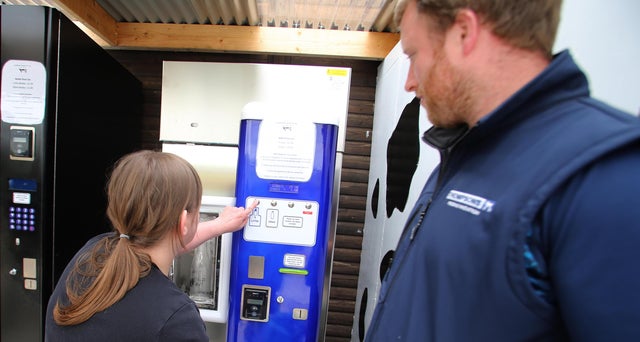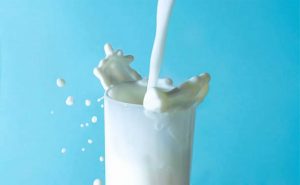The Scottish poet Robbie Burns had worked at the farm in the 1700’s.
The current, third generation, owner Bryce Cunningham took over the farm and, like a lot of dairy farmers, was losing money.
Large industrial scale dairies were paying him 15p a litre for his milk which meant it wasn’t sustainable. He decided to go back to basics, told the dairy he was no longer supplying them with milk and then decided to sell his milk directly to the public. He installed a pasteuriser on the farm and the milk was bottled, using Robbie Burn’s face as his logo. He started a doorstep delivery and now supplies 250 of the top coffee shops and restaurants in Scotland.
I’m old enough to remember milk being delivered in glass bottles and the empties being taken away the next day. In the eighties society changed and this sustainable and ethical way of supplying milk was replaced by plastic bottles. Plastic has become a blight on our ecosystem.
Chestnutt Farm is a dairy farm owned by William and Allison Chestnutt, located just outside Portrush on the road to Ballymoney.
Recently they have added a vending machine to their farm supplying the public with milk, pasteurised on the farm and dispensed into glass bottles. It’s the first of its kind in Northern Ireland and has been extremely popular. The milk is thick and you get a lovely cream top – you will never get that from a plastic blue top.
I must confess I don’t drink milk but I cook with it and appreciate its quality. The queues for the milk have been well documented on social media. They also have a vending machine for their eggs and they have ice-cold milk shakes available too.
The American chef and ethical farmer Dan Barber has said: “In the rush to industrialize farming, we’ve lost the understanding, implicit since the beginning of agriculture, that food is a process, a web of relationships, not an individual ingredient or commodity.”
When you see families waiting in line for this most natural, untouched milk Dan Barber’s words have a real resonance.
The Chestnutt’s have gone back to the way milk should be sold – from farm to bottle. There are no food miles, you refill your existing bottle and it’s completely novel. You’re visiting a working farm and can see exactly from where your milk has come from. Importantly, you’re supporting a local family business and giving them a fair price for their milk.
For me cooking with milk means only one thing – rice pudding.
My recipe is for a rich, decadent one using good milk and enriched with egg yolks. In the fifties and sixties rice pudding was usually paired with a dollop of rosehip syrup, a staple on school dinners. Rosehips are ripe for the picking at the moment and are great when they are made into a syrup. The rice pudding is swirled with the syrup and garnished with crunchy almonds and sugar dusted rosepetals. School rice pudding was never like this.
My other recipe is for a rhubarb and apple pudding topped with milk bun dough. The dough is a yeast one, slightly labour intensive, but worth the effort. Serve hot and bubbling from the oven with ice-cream or cream.













